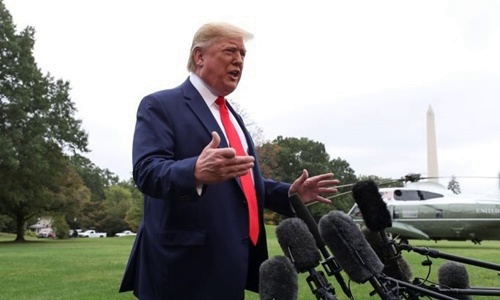In the middle of the White House lawn, the reporter stands in front of him and the Marine One helicopter is parked behind him, which is the perfect press conference for Trump.
The image of crowds of reporters, both men and women, gossiping, jostling, pushing each other, the person holding the camera, the owner of the recorder is no longer a rare sight in the beach. grass south of the White House. They are waiting for President Donald Trump to speak.

President Trump gave an interview on the lawn south of the White House on October 3 Photo: Reuters
The sound of the Marine One helicopter driving the White House boss grew louder, overwhelming the stirring talk. President Trump walked out of the White House, slowly approaching the eager crowd. He spoke into the microphone but the sound was swallowed up by the helicopter's engine.
"Mr. President," one reporter shouted, intending to ask Trump questions, but all he heard were only disjointed nouns "Turkey ... Syria ... Kurds ...".
That day, however, Trump did not answer the question, a rarity for him and a great disappointment for journalists. He turned and headed for the waiting helicopter. The atmosphere sagged.
The chaotic, lightning-quick interviews at the time the Marine One helicopter landed on the lawn south of the White House seemed to have become the typical motif of President Trump. This has become one of the most frequent places he has direct contact with the media.
The media meeting at the foot of Trump's helicopter is now no different than an event scheduled regularly, usually occurring whenever he leaves or returns to the city. The stop and talk with the helicopter on October 23 was the 75th time he has been doing this since taking office, according to Mark Knoller, a correspondent for CBS News in charge of reporting the White House. But a question that many people cannot help wondering is: Why?
Why does Trump want to meet the press in the open air? The White House has the perfect press conference room, indoors, unaffected by the weather, no loud noises from the helicopter, but the President prefers the south lawn with heat, moisture, wind, insects and winter frost.
"I think the President's actions have no other purpose but to increase the effectiveness and accessibility of reporters," said Stephanie Grisham, White House press secretary. "The press is always out there waiting for the president to leave anyway. So it's natural for him to stop and answer questions ... It's not like we called the press to the beach. south grass for the president to talk to. They have been waiting. "
However, reporters and others argue that Trump prefers freer Q&A sessions because they give him an advantage. The President of the United States can both gain attention and make it difficult for reporters, both on the auditory and the visual.
As in a meeting this week, even people standing just a few meters away from Trump could not ask questions because the helicopter engine sound was too loud. Trump himself frequently asks reporters to repeat the question. This act is like a kind of disguise, helping Trump ignore questions he doesn't like and move on to those he confidently answers, the expert said.
"He cannot easily refuse to answer if in a press conference," one reporter said, walking away from the White House lawn.
On the other hand, the noise of a noisy helicopter motor helps eliminate the "pitfalls" that journalists can raise in questions because amidst the noisy space, reporters often only ask with a few words or phrases. , just enough information, according to commentator Paul Farhi from the Washington Post.
Besides, reporters questioning are rarely seen. Unlike regular press conferences, where a series of cameras are fixed, journalists must bring the camera to the lawn south of the White House. This will limit far-flung scenes, where other related images are inserted in the middle of a continuation, helping to keep the focus straight on Trump.
In the open space of the lawn, Trump frequently walked in front of reporters, called any reporter, answered questions quickly, and then moved on to the next person. Freedom of movement will help the US President stop further questions or refute from reporters.
Overall, the press conference next to the helicopter was "a rite of dominance," said Todd Gitlin, a professor at Columbia's School of Journalism. "Everything is set to turn him into the commander, in full control of the media."
"He was not there to answer detailed or difficult questions. He forced the press to play by his rules," former CNN correspondent Frank White said.
Former ABC News correspondent Sam Donaldson used to shout questions to President Ronald Reagan frequently because he also gave interviews to the Marine One helicopter. But according to Donaldson, Trump's helicopter question and answer was completely different from previous President Reagan's previous press responses.
"Trump probably feels this is an easy way to hold a press conference," he said. "It's not like any past press conference. It's just another way for Trump to restrict journalism."
But Donaldson said he still admires the president's strategy. "Trump makes the crowd majestically. I know that his supporters like it. He's like a lion tamer. If there's a whip and a chair, he can come to Las. Vegas performance, "compared to Donaldson.



 DaveoWilko
DaveoWilko







